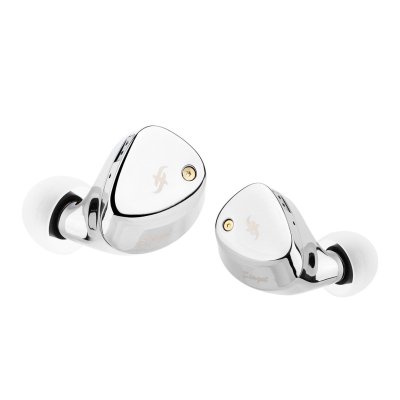FatFreq x HBB Deuce and Simgot ET142 use 2DD and 1Planar+1BC driver setups respectively. FatFreq x HBB Deuce costs $239 while Simgot ET142 costs $220. FatFreq x HBB Deuce is $19 more expensive. Simgot ET142 holds a slight 0.2-point edge in reviewer scores (7.2 vs 7.4). Simgot ET142 carries a user score of 7.3.
Insights
| Metric | FatFreq x HBB Deuce | Simgot ET142 |
|---|---|---|
| Bass | 7 | 7.4 |
| Mids | 7 | 7.4 |
| Treble | 5.5 | 7.4 |
| Soundstage | 6 | 7.4 |
| Dynamics | 6 | 7.4 |
| Tonality | 7 | 7.5 |
| Technicalities | 6.1 | 8 |
FatFreq x HBB Deuce Aggregated Review Score
Average Reviewer Scores
Average Reviewer Score:
7.2Generally Favorable
Simgot ET142 Aggregated Review Score
Average Reviewer Scores
Average Reviewer Score:
7.4Generally Favorable
Reviews Comparison
FatFreq x HBB Deuce reviewed by Z-Reviews
Youtube Video Summary
FatFreq x HBB Deuce goes for big fun without getting dumb about it. Pricing is $240 (3.5mm) or $260 (4.4mm); the red fabric cable looks slick but feels a bit stiff, and that 4.4mm upcharge seems tied to the included impedance “bass” adapter—which is more novelty than necessity. The shells are long, big-boy housings with massive nozzles; surprisingly comfy for larger ears, but watch the deep 2-pin sockets when swapping cables. Silicone tips (e.g., Dunu SS) pair best; no “bass-helping” tips needed.
Sonically it’s smooth, warm, and wide with an 18 dB sub-bass shelf that stays tucked away until music actually digs below ~40 Hz. That means vocals, strings, and lighter tracks come through clean and spacious—nice soundstage, good detail, no mid-bass bloat smearing everything. Cue up bass-heavy cuts and the Deuce flips the switch: rolling, room-shaking rumble that’s almost too much with the adapter and perfectly rowdy without it. Great for movies and cinematic scores, where that subterranean swell does the heavy lifting while the rest stays intact.
Value check: not a “punch above $1k” miracle, but a solid buy around $250 if the brief is warm, wide, sub-bass fun that behaves on normal tracks. Bass-averse listeners should look elsewhere; bass enjoyers can expect occasional bursts of insanity on the right songs. Wishlist items: a less stiff cable and more forgiving connector depth—one sample even chipped at the socket during a cable pull. Otherwise, this collab does what it promises: big sub-bass when called for, musical and enjoyable the rest of the time.
Z-Reviews Youtube Channel
Simgot ET142 reviewed by Z-Reviews
Youtube Video Summary
SIMGOT ET142 comes across as a sleek, chrome-heavy hybrid with a planar + PZT setup, dressed in CNC’d stainless shells and a surprisingly thick premium cable, plus a magnetic case and swappable 4.4/3.5 plug. Two tuning nozzles are included; differences are subtle, but the gold nozzles give a warmer, more relaxed balance versus the blued “airier” set. At a listed ~$220, the build and accessories feel upscale, though that cable is borderline overkill for an IEM.
On power, the ET142’s 14 Ω load behaves better with a more linear solid-state source (e.g., JDS Labs Element) than with tubes; an impedance adapter can tame noise. The tuning reads smooth, non-aggressive, with bass present but not the star; sub-bass “slam” isn’t the focus, yet vocals and staging are clean and pleasing. Treble with the gold nozzles stays polite, while the blued set adds some sparkle without turning harsh.
The special sauce is the imaging: sound feels “inside” and slightly behind the head, creating a quirky but engaging sense of placement that should be excellent for gaming. Overall it fits neatly among planar hybrids at this price—refined, smooth, and easy to enjoy rather than a fireworks show—earning a straightforward recommendation, especially for SIMGOT fans who value comfort, build, and that distinctive spatial presentation over brute-force bass.
Z-Reviews Youtube Channel
Buy Simgot ET142 on Linsoul
Ad
Price: $219.99
Buy Simgot ET142 on Linsoul
FatFreq x HBB Deuce reviewed by Jays Audio
Youtube Video Summary
Pre-order chaos aside—months of delays, a mixed-up shipment, and widespread complaints about customer service—the FatFreq x HBB Deuce answers the only question bass fans care about: low-end authority. This tuning is a sub-bass-first sledgehammer with a thick, heavy texture and a slightly prolonged decay that adds extra rumble and “reverb” feel. Despite the graph dip discourse, the mids don’t sound hollow, and the mid-bass isn’t neutered—just less punch-centric than the sub-bass focus. Vocals stay reasonably clean, avoiding the fuzzy bleed heard on some rivals, while the upper-mids/treble run smoother and more relaxed than edgier basshead sets. If the optional impedance adapter is used, expect even more low-end emphasis.
On technical performance (~$200 class), this is not the detail, separation, or imaging benchmark; more balanced competitors retrieve more information and stage more cleanly. Where Deuce shines is fun factor: hip-hop, rap, and EDM benefit from the cavernous sub-bass and weighty slam. A curveball comparison is the ultra-budget E20 (2DD), which can measure up with quicker bass, clearer upper-mids, better treble extension, and generally sharper resolution—especially with EQ—but it won’t dig as deep or hit as heavy as Deuce. Net: for a no-EQ basshead pick under $300, Deuce is a guilty pleasure—just buy from reputable retailers (e.g., Amazon/Linsoul) rather than direct, given the fulfillment troubles reported by many users.
Jays Audio Youtube Channel
Simgot ET142 reviewed by Jays Audio
Youtube Video Summary
SIMGOT’s ET142 pairs a planar driver with a PZT, delivering a bright-leaning, lively all-rounder that feels like a more mature, slightly more detailed take on the original S12 tonality. Treble is the surprise: it carries bite and air without the usual planar “sizzle”, landing closer to a well-implemented PZT sheen. Micro-nuance on cymbal work is improved, vocals are open, and technical performance is among the best heard from planars in this bracket. The 2 kHz region can read a touch shy, while overall treble sits above Harman, so expect sparkle and energy rather than warmth.
Volume and fit matter. At mid levels (~60–65 dB) the ET142 sounds engaging and airy; push past ~70–75 dB and the upper energy can turn fatiguing, with forward vocals and sharper highs on busy tracks. Tip choice is critical: treble-boosting tips can be too much, whereas wide-bore, smoother tips (e.g., “Senai Wide”) keep the top end in check. Both included nozzles measure and sound essentially the same—an opportunity missed for a second, tamer tuning. Genre-wise, rock, indie and slower pop benefit from the speed and air; dense electronic can edge bright, while K-/J-pop stays bouncy at moderate volume.
Bass is quick, punchy and clean with tight decay and excellent separation—don’t expect DD-level rumble or lingering reverb, but do expect balance and definition. Versus safer, more relaxed tunings (S8/S15/S12 2024), the ET142 is the more exciting pick; against neutral all-rounders (e.g., “Pilgrim”), it trades smoothness for air and sparkle; compared to sets like “Dusk,” it’s livelier with less treble fizzle but a more forward top end. At around $200, build is excellent (metal shells, braided cable) and the value strong—competing with some $300–$400 options. In short: choose ET142 for a bright, technical, energetic listen; skip it if a laid-back or dark tilt is the goal.
Jays Audio Youtube Channel
FatFreq x HBB Deuce (more reviews)
FatFreq x HBB Deuce reviewed by Super* Review
Youtube Video Summary
FatFreq x HBB Deuce keeps the price sharp at $240 while pushing a bold aesthetic: a bright red, nylon-braided cable, recessed 2-pin connectors, and compact shells with a surprisingly flush fit. The nozzle measures about 6.7 mm with a firm lip, holding tips securely; comfort is generally good despite the semi-custom contours. Included is a 15Ω impedance adapter (≈16Ω measured) that can be inserted via 4.4 mm to goose the bass for experimentation.
Tonally, Deuce is an unapologetic mega-bass machine, yet cleverly sub-bass focused thanks to a lower-mid dip that avoids bloat. From roughly 200 Hz and up it tracks Harman-like: leaner lower mids, a crisp presence region, and typical DD treble that can edge bright on sibilant material. The result is a contrasty, V-ish profile with exaggerated width and depth—thrilling on hip-hop and electronic, occasionally exhausting or droney with mixes heavy in upper-bass guitars. Add the adapter and expect roughly +~5 dB more low-end wallop—absurd for everyday listening, but undeniably fun in the right mood.
Versus peers, Sennheiser’s IE300 is less bassy yet muddier and softer in attack; Deuce feels cleaner and snappier. Hisenior’s Mega5-EST Bass+ costs far more while its bass can seem unwelcome and intrusive next to Deuce’s purposeful slam. This set is a self-aware one-trick pony—a conversation starter that’s easy to share and hard not to grin at—earning a confident 4 stars for delivering maximalist fun without totally sacrificing clarity.
Super* Review original ranking
Super* Review Youtube ChannelFatFreq x HBB Deuce reviewed by Bad Guy Good Audio
Youtube Video Summary
FatFreq x HBB Deuce targets a very specific brief: the most affordable, most balanced, yet still impactful member of the Maestro line—built without balanced armatures and tuned with a Variations-style contour but with more slam. Low end checks the boxes across hip-hop and rock staples; 4/5-string bass lines have clean pull and ring, and the kick has that produced Bonham thump on “When the Levee Breaks.” Vocals—think Chris Cornell, Layne Staley, and Nina’s “Heart of Glass”—stay clear of bass bleed, the result of multiple physical sample rounds and FatFreq’s unique Bass Cannon V2 implementation. Overtones pop—electric/acoustic guitar, rides, crashes, keys—and the set delivers an unusually wide stage that holds up over long sessions.
The tuning philosophy mirrors the Moondrop Variations energy but hits harder via driver venting/porting and crossover work rather than brute mid-bass lifts, preserving rhythm section weight without trampling vocals. That balance is the point—male and female vocals ride on top while bass and drums punch underneath. There’s an optional impedance optimizer that morphs the Deuce toward a Scarlet Mini vibe for bigger slam, but it trades away some vocal finesse; it’s a fun switch for bassheads, not the intended baseline. Ignore the “25 dB” chatter—this collab’s goal wasn’t a bass-monster badge, it was a coherent, musical daily driver that crosses genres.
As a package, Deuce looks the part, leverages FatFreq’s latest bass tech, and offers a value gateway into the brand that can hang with pricier siblings. The default tuning brings the slam-without-bloat many wanted, while the adapter exists for those who crave extra rumble. With strong word-of-mouth and real-world playlists backing it, this feels like a lovable set in either configuration—one for balance and clarity, one for pure grin-inducing heft.
Bad Guy Good Audio original ranking
Bad Guy Good Audio Youtube ChannelFatFreq x HBB Deuce reviewed by Kois Archive
Kois Archive Youtube Channel
FatFreq x HBB Deuce reviewed by Audionotions
FatFreq x HBB Deuce reviewed by Jaytiss
Youtube Video Summary
FatFreq x HBB Deuce brings a compact, comfortable shell with a gray metallic finish and easy tip fitment; ergonomics and weight are spot-on. Packaging is straightforward but solid, and the stock cable is decent—secure chin slider and tidy Y-split—though a bit microphonic. The recessed 2-pin connector can be fragile if carelessly handled; a replacement unit solved earlier issues. A standout extra is the included impedance adapter (4.4mm), which meaningfully alters drive and response.
Sonically, this is a double dynamic driver set tuned for excitement: clean mids with realistic note weight, lively upper presence, and genuinely pleasing air and sparkle. The hallmark is a colossal bass shelf beginning around ~200 Hz—punchy, tactile, and sometimes “pop-out-of-nowhere” feisty. With the adapter, expect roughly ~10 dB more low-end and a need for a couple volume clicks, turning it into full-on guilty-pleasure territory. Despite the bass emphasis (and a slight “tuck” sensation), vocal presence stays intact and timbre remains cohesive for a DD-driven set.
Against FatFreq siblings and peers, Deuce feels more controlled than Scarlet Mini’s later-rising low shelf, cleaner and more coherent than Maestro Mini, and trades blows with Black Up while echoing some of the top-end fun found in Grand Maestro. Versus higher-priced favorites (e.g., Jupiter, Binary Dynaquattro), it gives up some refinement/extension but returns remarkable value around ~$240. For those craving “gigachad” bass without wrecking the mids, this is a distinctive, versatile daily that suits many genres and feels special at the price. Final take: a strong 87/100 and one of the most enjoyable recent HBB collabs—imperfect, yes, but thrilling and highly recommended for bass-inclined listeners.
Jaytiss Youtube Channel
FatFreq x HBB Deuce reviewed by Head-Fi.org
Simgot ET142 (more reviews)
Simgot ET142 reviewed by Audio Amigo
Youtube Video Summary
The Simgot ET142 is a $220 planar–piezo hybrid that arrives like a mini system: full-metal shells, the chunky but well-behaved LC7 modular cable (3.5/4.4 included), a sturdy magnetic case, and four tuning nozzles (titanium stock, gold, short black foam, short red foam). Build is solid and venting prevents pressure issues; finish is a fingerprint magnet and the shell+cable combo is heavy, comfortable for average ears but failing the “tiny ears” test in stock form. Accessory spread is excellent at the price, with multiple tip sets and spare O-rings/foams rounding out a thoughtful package.
Sonically, this is textbook planar bass: clean sub-bass rumble with punchy, textured mid-bass that doesn’t bleed. The midrange stays clear and unmasked, presenting busy mixes with ease, while vocal presence shifts with nozzle choice (short nozzles push fundamentals slightly forward). Treble is where the nozzles matter most: short red = relaxed and smooth; short black = balanced sparkle; titanium/gold = vivid, edging toward “hot” for treble-sensitive listeners. Technical chops impress—crisp microdetail from the PZT without harshness, precise imaging, strong separation, and a notably 3D soundstage. It’s also very easy to drive, playing happily from modest sources.
Think of ET142 as a three-in-one planar: titanium delivers a bright, energetic V-shape (S12/“classic planar” territory), short black dials it to a balanced, less aggressive profile (S12 Pro/2024 vibe), and short red shifts into the modern warm planar lane (akin to S15/S08). Compared with other nozzle-swap sets (e.g., Timeless 2), ET142 offers a wider tuning range up top, trading fine micro-timbre tweaks for genuinely distinct signatures. Caveats: none of the nozzles are truly neutral and the low end stays boosted, so lean-bass seekers should look elsewhere; the weight may be a deal-breaker for small ears. For anyone wanting a versatile planar that can swing from sparkly and fun to warm and relaxing with a quick nozzle swap, this earns a confident “you should buy this” recommendation on value and flexibility alone.
Audio Amigo Youtube Channel
Simgot ET142 reviewed by
 Fresh Reviews
Fresh Reviews
Youtube Video Summary
Build & accessories: ET142 arrives with an all-metal chassis, a tidy two-pin cable with interchangeable termination, and swappable nozzles (blue default vs. gold). The blue nozzle proves smoother, as the gold adds extra 2–3 kHz energy that can edge into shout. Ergonomics are compact, vented, and well-finished, though not as feather-light as some resin competitors.
Tuning & technicals: The hybrid architecture (planar plus bone-conduction) projects an expansive, airy stage with clean separation and layering. However, that upper-mid peak can make gunfire and busy mixes feel a bit spicy, leading to a “deer-in-headlights” sensation during chaotic moments. Tonally it’s clear and detailed, but the extra air sometimes pushes nearfield cues slightly forward in the stage instead of delivering immediate urgency.
Gaming performance: Imaging and verticality are solid and footstep cues are intelligible, placing ET142 in a B+ to B range for competitive play. Against a warmer rival with stronger low-end presence, ET142 is less fatiguing than the gold-nozzle setup but still brighter than ideal for Apex/Valorant chaos; the rival’s bass weighting keeps gunfire tamed and localization snappier. Overall, ET142 is good for gaming with strong separation and stage, best for players who value clarity and air over maximum urgency.
Fresh Reviews original ranking
Fresh Reviews Youtube ChannelFatFreq x HBB Deuce Details
Driver Configuration: 2DD
Tuning Type: n/a
Price (Msrp): $239
Support our free service! Buying through our affiliate links costs you nothing extra:
Simgot ET142 Details
Driver Configuration: 1Planar+1BC
Tuning Type: V-Shaped
Brand: Simgot Top Simgot IEMs
Price (Msrp): $220
Support our free service! Buying through our affiliate links costs you nothing extra:
FatFreq x HBB Deuce User Review Score
Average User Scores
Average User Score: n/a
Based on 0 user reviews
No user reviews yet. Be the first one who writes a review!
Simgot ET142 User Review Score
Average User Scores
Average User Score:
Based on 1 user reviews
7.3Generally Favorable
FatFreq x HBB Deuce Gaming Score

Gaming Score & Grade
- The gaming score is prioritizing technical capabilities of the IEM (Separation, Layering, Soundstage) and good value.
Gaming Score
6.4Gaming Grade
BSimgot ET142 Gaming Score

Gaming Score & Grade
- The gaming score is prioritizing technical capabilities of the IEM (Separation, Layering, Soundstage) and good value.
Gaming Score
8.1Gaming Grade
A+FatFreq x HBB Deuce Scorings
Average Technical & Tuning Grades
Average Tunign Grade
A-- Expect an inviting tonal blend that adapts well to genres while staying largely composed. It strikes a nice blend of warmth and clarity.
Average Technical Grade
B- Overall technicalities are acceptable, delivering enough clarity for casual sessions. Imaging is serviceable though not immersive.
Simgot ET142 Scorings
Average Technical & Tuning Grades
Average Tunign Grade
A- Tuning feels well executed, keeping a natural flow across the spectrum. Switching genres feels seamless.
Average Technical Grade
A+- A very capable technical display delivers articulate layers and poised imaging. It portrays reverbs and echoes with confidence.
FatFreq x HBB Deuce User Reviews
"This is an example review"
Pros
- Example pro 1
- Example pro 2
Cons
- Example con 1
- Example con 2
Share your experience and build your personal ranking list.
You need to be signed in to write your own reviewSimgot ET142 User Reviews
Share your experience and build your personal ranking list.
You need to be signed in to write your own reviewThe Simgot ET142 delivers a smooth and natural sound signature with strong mids but lacks impact in the bass region.
Pros
Clear and detailed mids with good instrument separation; solid build quality and comfortable fit.Cons
Bass can feel a bit light for bassheads; soundstage is average and not very wide.Find your next IEM:
IEM Finder Quiz
newIEM Comparison Tool
newVS






















